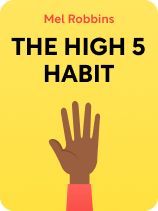

This article is an excerpt from the Shortform book guide to "The High 5 Habit" by Mel Robbins. Shortform has the world's best summaries and analyses of books you should be reading.
Like this article? Sign up for a free trial here.
What is Mel Robbins’s High Five Challenge? How easy it is to improve your self-esteem?
When you’ve had a tough day, it’s reassuring to know that the next day you can start from scratch. By just looking in the mirror and giving yourself a high five in the morning, you can improve your day and your confidence level.
Continue reading to learn how to do the High Five Challenge, according to The High 5 Habit by Mel Robbins.
How Do You Build a High Five Challenge?
Mel Robbins’s High Five Challenge begins with three simple steps.
- When you first wake up, go to your bathroom and look in the mirror. Observe your reflection and think about what you love about who you are as a person.
- Give your reflection a high five.
- Repeat every day.
| How to Build a Habit Charles Duhigg, author of The Power of Habit, elaborates on what you can do to help form a new habit, like giving yourself a high five every morning. He argues that all habits require three elements: 1. The cue: The cue is a signal that triggers the brain to initiate a particular behavior. It can be something internal or external, such as a specific time of day, a particular location, an emotional state, or even the presence of certain people. Cues can vary depending on the habit and the individual. 2. The routine: The routine is the behavior itself—the action or series of actions that you perform in response to the cue. This is the habitual behavior that you want to establish or change. It can be a physical action, a thought process, or an emotional response. 3. The reward: The reward is the positive reinforcement that follows the routine. It’s something that satisfies a desire or craving and reinforces the brain to remember and repeat the habit loop in the future. Rewards can take various forms, such as physical pleasure, emotional satisfaction, a sense of accomplishment, or even social recognition. According to Duhigg, these three elements—cue, routine, and reward—work together to create and reinforce habits. As you’re trying to build the habit of a morning high five, think about what cues you can implement as a reminder to give yourself a high five. This might be an alarm on your phone or a note next to your toothbrush. Then, when you give yourself a high five, pay attention to how you feel afterward and notice the emotional reward you get from following through with your routine. |
This daily habit of giving yourself a high five helps remind you, before you’ve done anything else, to shift your focus from the negative to the positive. But the high five alone isn’t enough. You also need to interrupt negative thoughts as they occur and reframe underlying unproductive emotions that lead to those negative thoughts.
(Shortform note: The daily high five is an example of what James Clear calls an “atomic habit,” a small, incremental behavior that’s easy to do and takes minimal effort but has a significant impact. In Atomic Habits, he explains that these behaviors are specific, actionable, and can be performed consistently. They focus on making tiny improvements that may seem insignificant in isolation but, when practiced consistently, can result in profound personal growth.)
Address Negative Thoughts
Starting your day with a high five is intended to remind you that you’re worthy and capable. But, throughout the day, you’re still bound to have moments of self-doubt or negative self-talk. Taking part in the High Five Challenge means not just giving yourself a high five every morning but also cultivating a positive attitude—an inner voice that always celebrates and affirms you. A positive attitude requires you to confront the negative thoughts that tear you down rather than lift you up.
Robbins offers a three-step process to help you transform negative thoughts as they arise.
Step 1: Interrupt the negative thought as it occurs. Robbins recommends simply redirecting your focus anytime you notice a negative thought about yourself come up.
Step 2: Replace the negative thought with a meaningful affirmation, for example, “I’m capable of building the life I want.” She emphasizes that affirmations only work if you truly believe what you’re saying, so try out a few to find some that work for you. Once you find an affirmation that rings true, she recommends writing it down somewhere where you’ll see it often, maybe on your bathroom mirror where you’ll see it every time you give yourself a high five.
Step 3: Finally, take an action step that proves your affirmation to be true. For example, if your affirmation is “I learn something new every day” then you could end your day by sharing something you learned with a friend or family member.
Change Your Mind, Change Your Life
Robbins argues that shifting your focus from negative to positive self-talk and starting with a daily high five will help you realize your dreams. Capitalizing on the power of your brain’s RAS, you can align your thoughts and actions with your goals. She argues that when you visualize your dreams and consistently focus on them, your RAS increases your awareness of opportunities and resources that will help you get there.
(Shortform note: Robbins’s explanation of the power of the RAS closely aligns with The Law of Attraction, a theory popularized by Rhonda Byrne in her 2006 self-help book, The Secret. Byrne argues that our thoughts and emotions can shape our reality. She explains that by aligning your beliefs, intentions, and actions with your desired outcomes you can realize your dreams. Although there’s no concrete scientific evidence supporting the existence of the Law of Attraction, proponents argue that it aligns with theories from quantum physics.)

———End of Preview———
Like what you just read? Read the rest of the world's best book summary and analysis of Mel Robbins's "The High 5 Habit" at Shortform.
Here's what you'll find in our full The High 5 Habit summary:
- Why you should start each day by giving your reflection a high five
- How to silence self-doubt and adopt an attitude of confidence and self-love
- The psychology behind why high fives make you feel good






